Reconnect with Your Core Postpartum: How Breath Equals Strength

Pregnancy and childbirth change your body in incredible ways, but they can also impact core strength and stability. Many postpartum moms struggle with diastasis recti, pelvic floor dysfunction, and weakened core muscles. The good news? Your breath is the key to rebuilding core strength.
In this guide, we’ll explore how to properly engage your core postpartum using breathwork and movement to create strength from within.
Why Core Engagement Matters
Many people associate core engagement with the common cue: “belly button to spine.” There’s nothing wrong with it, but often this leads to sucking in the stomach rather than properly activating the transverse abdominis (deep core muscles).
True core activation starts with breath control, which manages intra-abdominal pressure and supports the pelvic floor, diaphragm, and deep core muscles.
Step 1: It Starts with Your Inhale
Inhale through your nose and expand your ribs all around—front, sides, and back. Avoid simply breathing into your belly. A good cue is to place your hands on your hips and slide them up until your thumbs touch your last rib. Focus on breathing into your thumbs.
Why This Matters
- Expanding the ribs prepares the core for activation.
- Breathing into your ribcage, belly and back (not your chest and shoulders) prevents excess pressure on the abdominal wall.
- Encourages proper diaphragm function, reducing tension in the neck, shoulders and pelvic floor.
Step 2: Exhale & Engage
On the exhale, draw your belly in and up as if zipping tight jeans. This engages the deep core muscles without over-clenching.
Important Cues for Proper Core Engagement
- Exhale through pursed lips while gently drawing the core inward.
- Avoid over-squeezing or bracing too hard.
- Pay attention to your shoulders—keep them relaxed.
By using this technique, you activate your core effectively without straining.
Step 3: Apply It to Movement
The goal is to match your breath to your movement to build strength while protecting your core and pelvic floor.
How to Sync Breath with Movement
- Inhale on the easy part of the exercise (e.g., lowering into a squat).
- Exhale on the hard part (e.g., standing up from a squat).
This method helps distribute intra-abdominal pressure properly and reduces strain on the pelvic floor.
To Summarize
- Breathwork is essential for postpartum core recovery.
- Avoid "sucking in"—focus on rib expansion and deep core activation.
- Inhale on the easy part, exhale on the hard part of an exercise.
- Practice with simple movements like bodyweight squats before progressing.
By incorporating breath-focused core activation, you’ll rebuild strength safely and effectively postpartum.
💡 Have you tried core-focused breathwork postpartum? Let me know in the comments!
✨ Follow @getmovingwithjen on instagram for more prenatal and postpartum fitness tips!
References
- American College of Obstetricians and Gynecologists (ACOG). "Postpartum Exercise: What You Need to Know." ACOG.org
- National Institute of Health (NIH). "The Role of Breathwork in Core Activation and Pelvic Floor Health." NIH.gov
- Mayo Clinic. "Rebuilding Core Strength After Pregnancy." MayoClinic.org
- Harvard Health Publishing. "The Importance of Diaphragmatic Breathing in Strength Training." Harvard.edu

